Java-Spring入门指南(十一)代理模式与Spring AOP实战
前言
在前一篇博客中,我们掌握了Spring纯Java类配置的技巧,彻底摆脱了XML的束缚。
- 而Spring中另一项核心技术——面向切面编程(AOP),能让我们在不修改原有业务代码的前提下,为方法添加额外功能(如日志、事务、权限校验等)。
我的个人主页,欢迎来阅读我的其他文章
https://blog.csdn.net/2402_83322742?spm=1011.2415.3001.5343
我的Java-Spring入门指南知识文章专栏
欢迎来阅读指出不足
https://blog.csdn.net/2402_83322742/category_13040333.html?spm=1001.2014.3001.5482

Spring的官方AOP讲解网站
https://docs.spring.io/spring-framework/docs/current/spring-framework-reference/core.html#aop
一、代理模式
代理模式的核心是:通过“代理对象”代替“真实对象”,在不修改真实对象的前提下,为其添加额外功能。
我们用房东中介租客的例子来列举一下
- 房东(真实对象):有房子要租,但不想直接和租客打交道,还想在租房前后做额外操作(如签合同、收押金)。
- 中介(代理对象):代替房东与租客交互,能在“租客租房”的前后添加自己的操作(如带看、收中介费)。
- 租客(调用者):只需和中介交互,就能完成租房,无需关心房东的细节。
1.1 静态代理
静态代理需要手动为每个真实对象编写对应的代理类,步骤如下:
步骤1:定义租房接口(抽象行为)
// 租房接口:定义租房的核心行为
public interface Rent {
void rentHouse(); // 租房方法
}步骤2:实现房东类(真实对象)
// 房东:真实对象,实现租房接口
public class Landlord implements Rent {
@Override
public void rentHouse() {
System.out.println("房东:我的房子成功租出去了");
}
}步骤3:编写中介类(代理对象)
// 中介:代理对象,也实现租房接口
public class Mediator implements Rent {
private Landlord landlord; // 持有真实对象(房东)的引用
public Mediator(Landlord landlord) {
this.landlord = landlord;
}
@Override
public void rentHouse() {
// 租房前:中介的额外操作
System.out.println("中介:带租客看房,收取中介费");
// 调用真实对象的核心方法
landlord.rentHouse();
// 租房后:中介的额外操作
System.out.println("中介:协助签合同,收取押金");
}
}步骤4:测试静态代理
public class ProxyTest {
public static void main(String[] args) {
// 1. 创建真实对象(房东)
Landlord landlord = new Landlord();
// 2. 创建代理对象(中介),并传入房东
Mediator mediator = new Mediator(landlord);
// 3. 通过中介租房(调用代理对象的方法)
mediator.rentHouse();
}
}运行结果: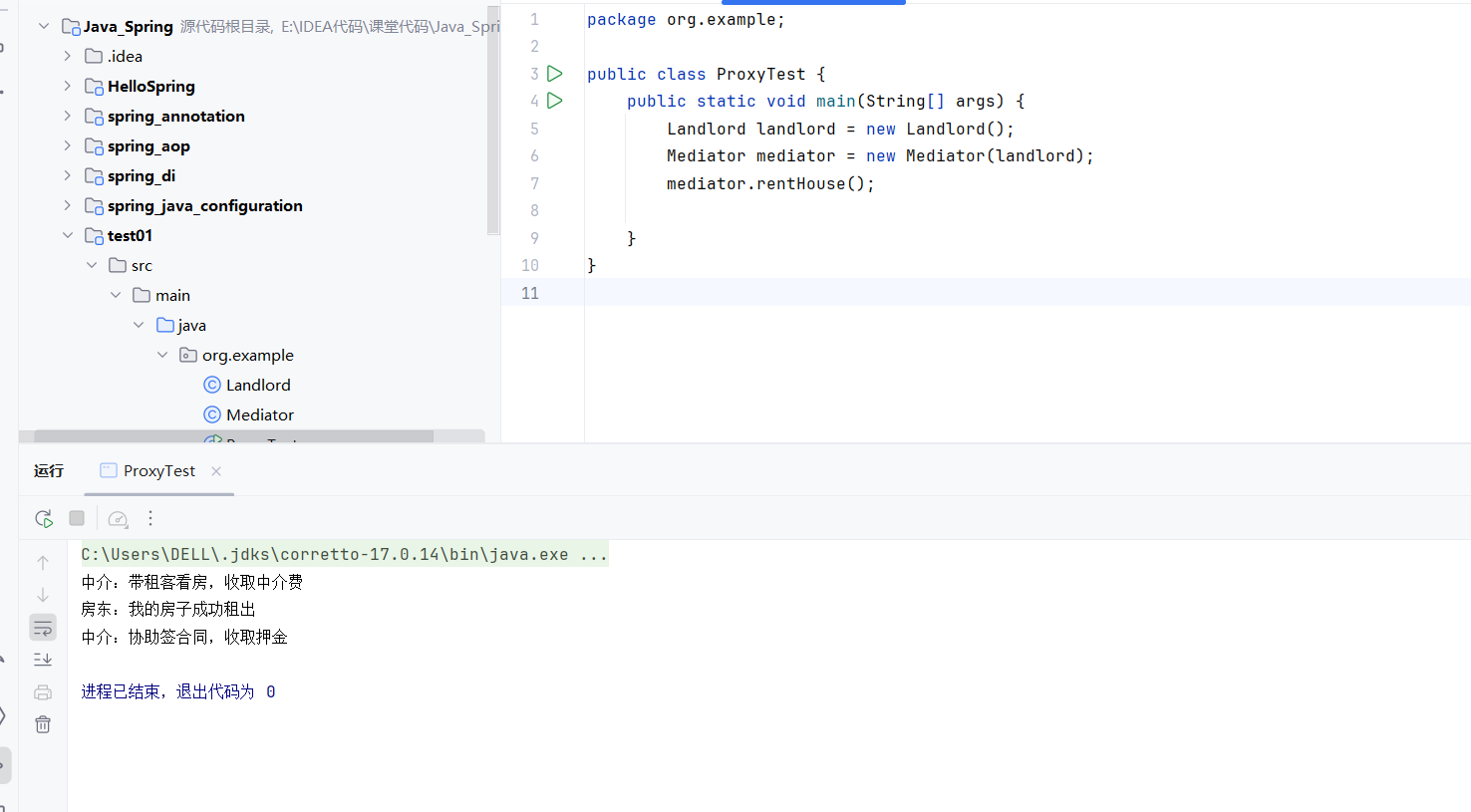
静态代理的优缺点
- 优点:逻辑直观,能在不修改真实对象的前提下,为其添加额外功能。
- 缺点:代理类与真实对象绑定,若有100个真实对象,就得写100个代理类,代码冗余且维护成本高。
1.2 动态代理
动态代理无需手动编写代理类,而是运行时自动生成代理对象(常见的有JDK动态代理——基于接口、CGLIB动态代理——基于子类)。
但动态代理的底层代码较为复杂,而Spring AOP帮我们封装了这些细节,让我们能更简单地使用AOP。
二、AOP是什么?
静态代理的“一对一”绑定方式,在复杂业务中会变得非常繁琐。而AOP(Aspect Oriented Programming,面向切面编程) 正是为解决这个问题而生:它能通过“切面”,对多个类的多个方法 统一添加增强功能,完全无需手动编写代理类。
2.1 AOP是什么?
AOP是一种编程思想,核心逻辑是:将与核心业务无关,但又分散在多个业务中的通用功能(如日志、事务、权限),抽取成“切面(Aspect)”,在合适的时机(如方法执行前/后),动态“织入”到业务方法中。

简单来说:业务代码只关注核心逻辑,通用功能交给AOP统一处理。
2.2 AOP有什么用?
AOP专为解决“横切关注点”问题而生:
- 横切关注点:与业务逻辑无关,但需在多个业务方法中重复出现的逻辑(如日志打印、事务控制、异常处理、权限校验等)。
- AOP的价值:让横切关注点与业务逻辑解耦,只需写一次,就能作用于多个方法,既减少代码冗余,又便于统一维护。
2.3 AOP的使用场景是什么?
AOP的典型应用场景包括:
- 日志记录:方法执行前/后自动记录日志。
- 事务管理:方法执行前开启事务,执行后提交/回滚事务。
- 权限校验:方法执行前校验用户权限。
- 性能监控:统计方法的执行时间。
- 异常处理:统一捕获和处理方法中的异常。
2.4 AOP的核心特点是什么?
- 切面(Aspect):横切关注点的封装(如“日志切面类”),包含“何时增强”“增强哪些方法”“做什么增强”。
- 通知(Advice):切面中的具体增强逻辑(如“方法执行前打印日志”),分为前置通知(before)、后置通知(after)、环绕通知(around)等。
- 连接点(Join Point):程序中可以被增强的点(Spring AOP中主要指方法调用)。
- 切入点(Pointcut):具体要增强的连接点,通过表达式指定(如“增强com.niit包下所有Service的方法”)。
- 织入(Weaving):将切面的通知“织入”到目标方法的过程(Spring在运行时完成织入)。
三、AOP在Spring中的应用
Spring对AOP提供了完善的支持,我们可以通过XML配置或注解实现AOP。下面结合代码,用XML配置方式实战Spring AOP。
3.1 准备依赖
使用Spring AOP需添加aspectjweaver依赖:
<!-- AspectJ织入依赖:支持AOP功能的核心依赖 -->
<dependency>
<groupId>org.aspectj</groupId>
<artifactId>aspectjweaver</artifactId>
<version>1.9.9.1</version>
</dependency>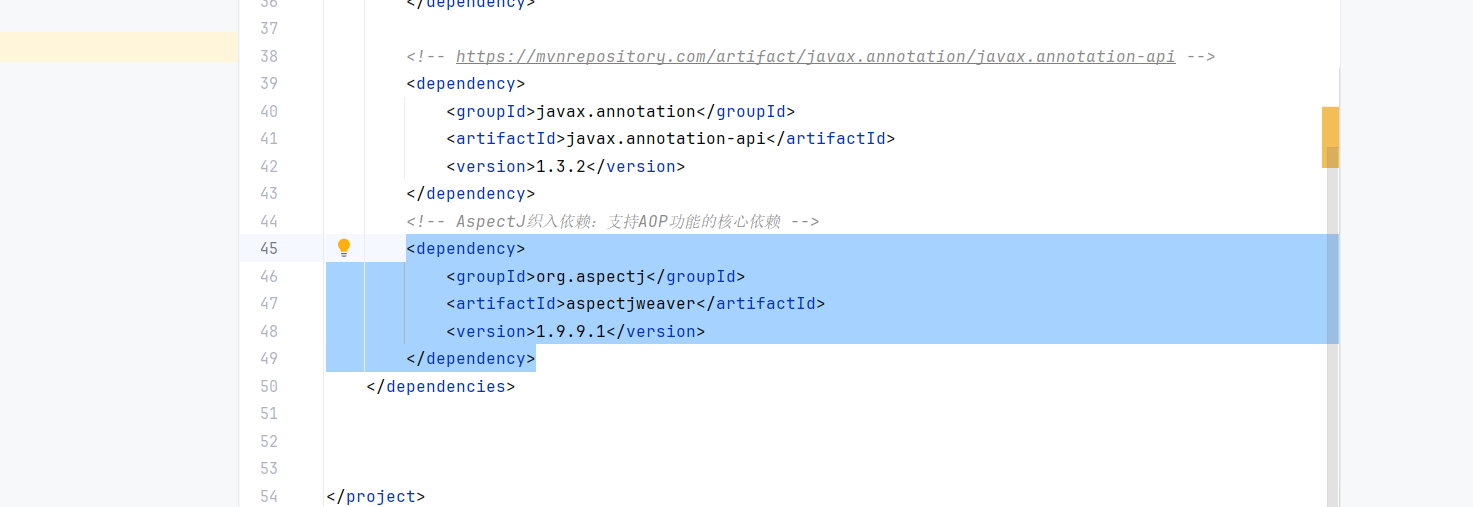
3.2 配置Spring的AOP命名空间
在applicationContext.xml中,添加AOP的命名空间和约束:
<?xml version="1.0" encoding="UTF-8"?>
<beans xmlns="http://www.springframework.org/schema/beans"
xmlns:context="http://www.springframework.org/schema/context"
xmlns:aop="http://www.springframework.org/schema/aop"
xmlns:xsi="http://www.w3.org/2001/XMLSchema-instance"
xsi:schemaLocation="http://www.springframework.org/schema/beans
http://www.springframework.org/schema/beans/spring-beans.xsd
http://www.springframework.org/schema/context
http://www.springframework.org/schema/context/spring-context.xsd
http://www.springframework.org/schema/aop
http://www.springframework.org/schema/aop/spring-aop.xsd">
<!-- 组件扫描:让Spring管理带@Service/@Component等注解的类 -->
<context:component-scan base-package="org.example.aop1"/>
</beans>3.3 定义业务接口与实现类
定义接口和实现类:
学生服务接口(StudentService.java)
public interface StudentService {
void add(); // 添加学生
void del(); // 删除学生
void update();// 修改学生
void query(); // 查询学生
}学生服务实现类(StudentServiceImpl.java)
import org.springframework.stereotype.Component;
// 注册为Spring的Bean,id为"ssi"
@Component("ssi")
public class StudentServiceImpl implements StudentService {
@Override
public void add() {
System.out.println("【核心业务】添加学生");
}
@Override
public void del() {
System.out.println("【核心业务】删除学生");
}
@Override
public void update() {
System.out.println("【核心业务】修改学生");
}
@Override
public void query() {
System.out.println("【核心业务】查询学生");
}
}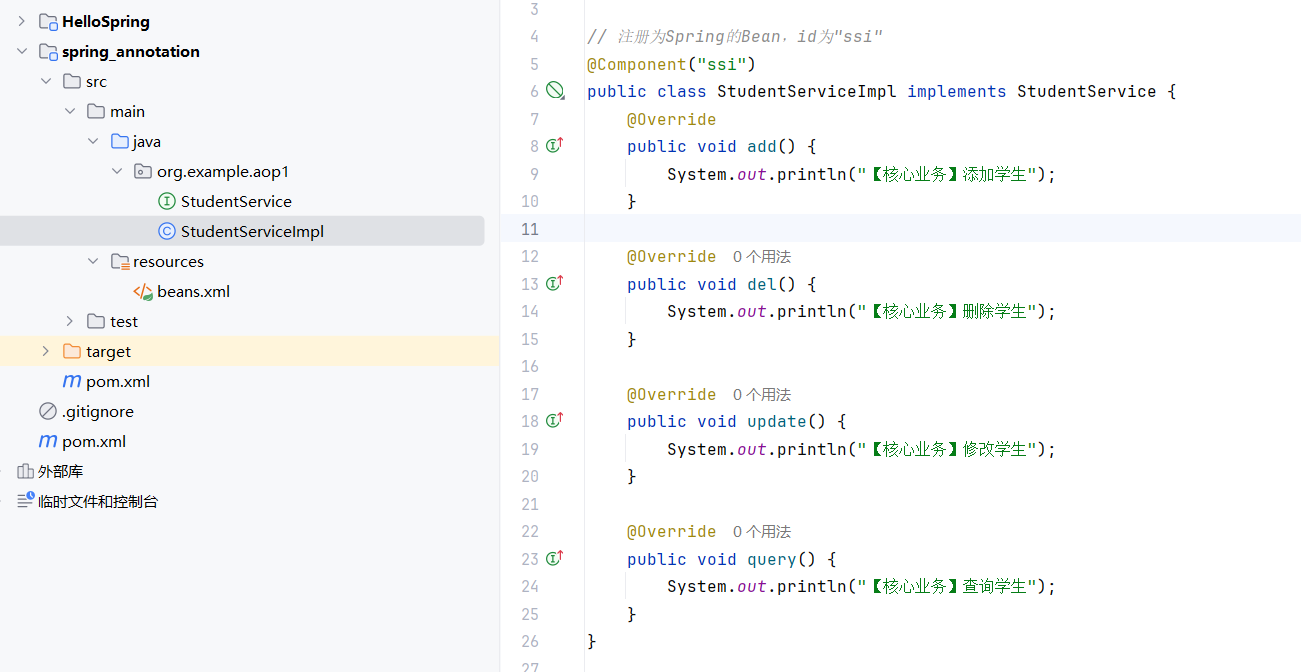
3.4 定义“切面”类(增强逻辑)
创建“日志切面”,在方法执行前打印增强信息:
import org.springframework.aop.MethodBeforeAdvice;
import org.springframework.stereotype.Component;
import java.lang.reflect.Method;
// 注册为Spring的Bean
@Component
public class LogBefore implements MethodBeforeAdvice {
/**
* 方法执行前的增强逻辑
* @param method 被增强的方法
* @param args 方法参数
* @param target 被增强的目标对象
*/
@Override
public void before(Method method, Object[] args, Object target) throws Throwable {
System.out.println("【AOP增强】" +
"类:" + target.getClass().getName() +
",方法:" + method.getName() +
" 即将执行~");
}
}3.5 配置AOP:指定切入点与通知
在applicationContext.xml中,配置“哪些方法”要被“哪个切面”增强:
<!-- AOP配置:将增强逻辑织入目标方法 -->
<aop:config>
<!-- 1. 定义切入点:通过表达式指定要增强的方法 -->
<!-- execution(* com.niit.aop1.*.*(..)) 含义:
- 第一个*:返回值类型任意
- com.niit.aop1.*:com.niit.aop1包下的任意类
- 第二个*:类中的任意方法
- (..):方法参数任意(个数、类型不限)
-->
<aop:pointcut id="myPointcut" expression="execution(* org.example.aop1(..))"/>
<!-- 2. 配置通知:将LogBefore的增强逻辑,织入到myPointcut指定的方法中 -->
<aop:advisor advice-ref="logBefore" pointcut-ref="myPointcut"/>
</aop:config>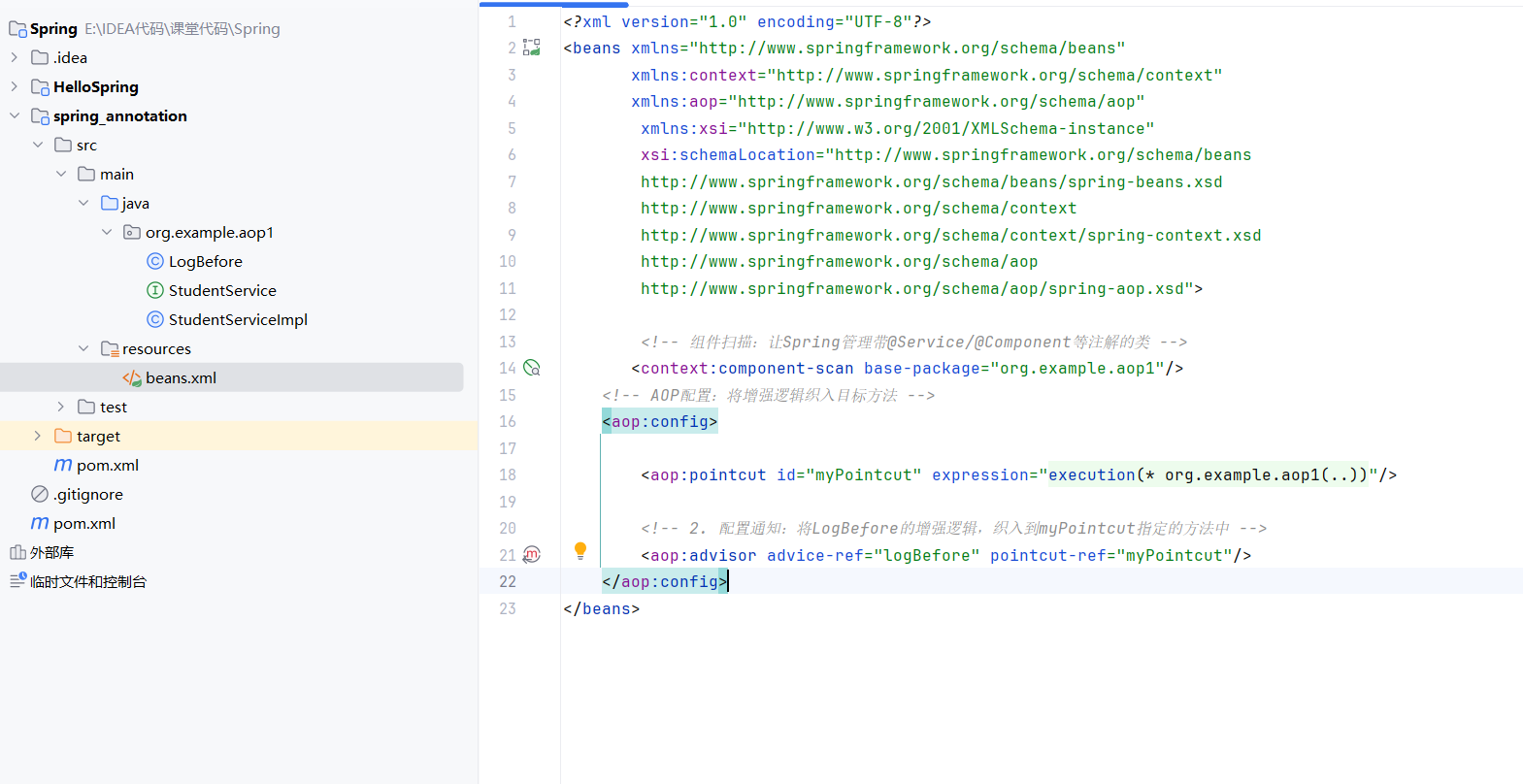
配置说明:
aop:pointcut:通过expression表达式定义切入点(要增强的方法)。aop:advisor:将通知(advice-ref指定的LogBefore)与切入点(pointcut-ref指定的myPointcut)关联,完成“织入”。
四、测试Spring AOP
编写测试类,获取StudentService的Bean并调用方法,观察AOP是否生效:
import org.springframework.context.support.ClassPathXmlApplicationContext;
public class MyTest {
public static void main(String[] args) {
// 加载Spring配置文件
ClassPathXmlApplicationContext context =
new ClassPathXmlApplicationContext("applicationContext.xml");
// 获取StudentService的Bean(注意:此时获取的是Spring生成的代理对象)
StudentService studentService = (StudentService) context.getBean("ssi");
// 调用方法,触发AOP增强
studentService.add();
studentService.query();
// 关闭容器
context.close();
}
}运行结果: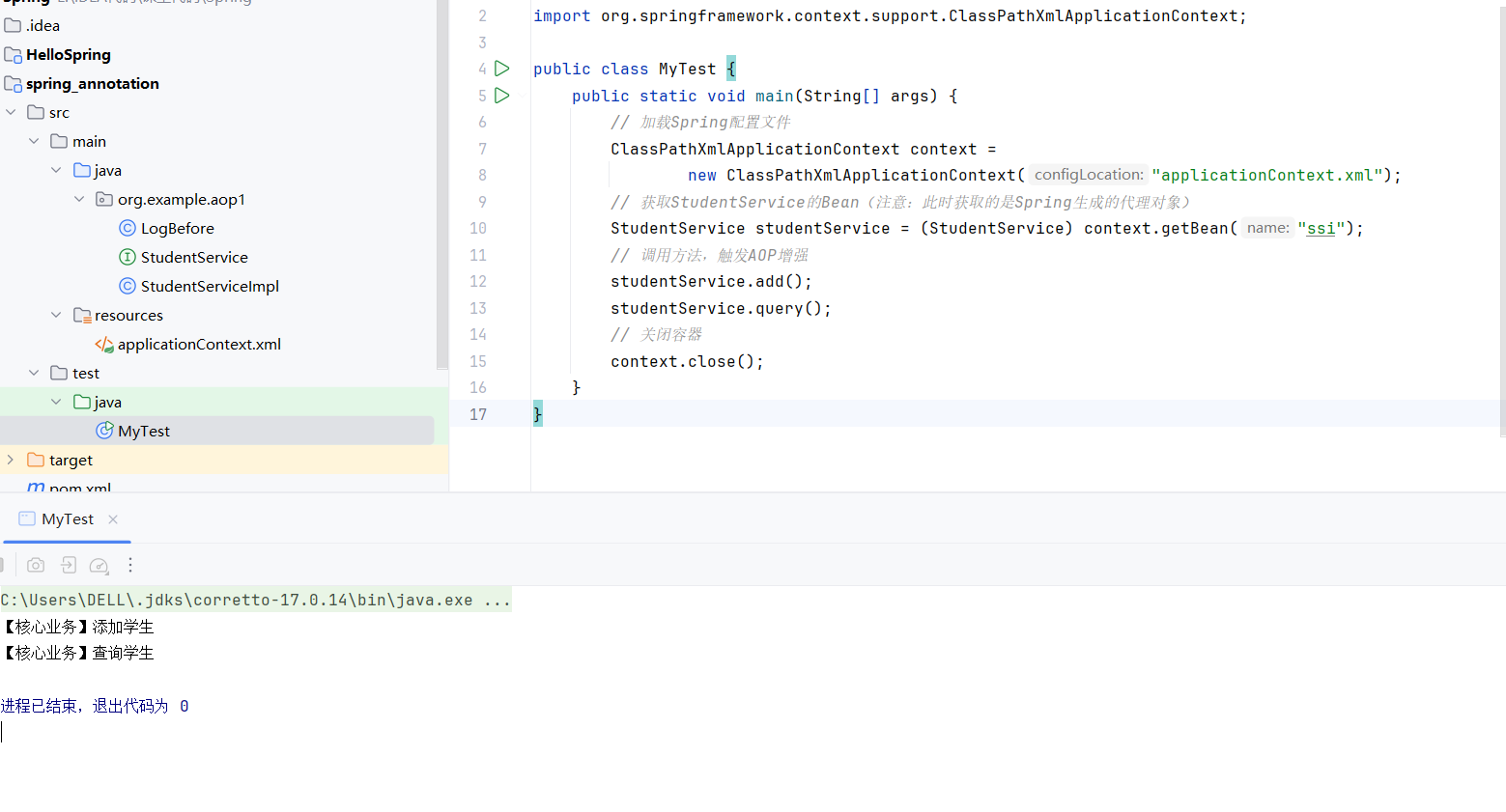
可以看到:无需修改StudentServiceImpl的代码,方法执行前自动添加了日志增强逻辑——这就是AOP的“无侵入式增强”魅力。
我的个人主页,欢迎来阅读我的其他文章
https://blog.csdn.net/2402_83322742?spm=1011.2415.3001.5343
我的Java-Spring入门指南知识文章专栏
欢迎来阅读指出不足
https://blog.csdn.net/2402_83322742/category_13040333.html?spm=1001.2014.3001.5482
| 非常感谢您的阅读,喜欢的话记得三连哦 |







 浙公网安备 33010602011771号
浙公网安备 33010602011771号